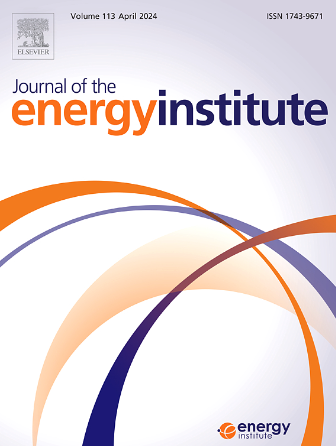Key reaction pathways for NO reduction by NH3 in the reduction zone during ammonia-coal co-firing: A combined experimental and DFT study
IF 5.6
2区 工程技术
Q2 ENERGY & FUELS
引用次数: 0
Abstract
Ammonia, as a zero-carbon fuel, is also a reducing agent for nitrogen oxides. During ammonia-coal co-firing, the reaction temperature window and atmosphere for ammonia and nitrogen oxides are usually different from those in SCR or SNCR, thus inhibiting the reduction effect of NH3 on NO. It is of great significance to further explore the reaction mechanism and kinetic characteristics of NO reduction with a wider temperature range and different oxygen concentration for optimizing the reaction environment and reducing nitrogen oxide emissions during ammonia co-firing processes in pulverized coal boilers. To explore the characteristics of NO reduction by NH3 under high-temperature reducing atmosphere, experiments were carried out on a one-dimensional tubular reactor at 1273–1773 K in 0–3% O2. The effects of temperature and oxygen on the denitrification efficiency were investigated. The detailed mechanism was analyzed to obtain the skeleton reactions under the present conditions. Experimental results showed that as the O2 concentration decreases, the temperature window for NO reduction shifts towards higher temperatures, and the maximal NO reduction efficiency is improved. The results of chemical kinetic simulation indicated that increasing O2 concentration or temperature can promote the reaction of NH3+OH=NH2+H2O and NH2+OH=NH+H2O, and promote the formation of NH2 and NH radicals. NH2 and NH radicals are essential for NO reduction under high-temperature reducing atmosphere. DFT calculations revealed that the process of NO reduction by NH2 is that NH2 combines with NO to form H2NNO, and then a H atom in H2NNO is transferred to O atom to form HNNOH. The decomposition of HNNOH produces different products, on the one hand, the O-N bond in HNNOH is broken to form NNH and OH radicals, on the other hand, the H atom in HNNOH is transferred from the N atom to the O atom to form N2 and H2O. The process of NO reduction by NH is that NH combines with NO to form HNNO, and HNNO decomposes to produce different products. On the one hand, the H-N bond in HNNO is broken to form H radical and N2O, on the other hand, the H atom in HNNO is close to and bonded with the O atom to form N2 and OH radical. At 1273–1773 K, the reaction rate constant of NO reduction by NH2 is in the range of 107-1010 s−1, and the reaction rate constant of NH2 radical oxidation and NH2 conversion to NH is lower. When there is trace oxygen in the environment, the concentration of OH and NH2 radicals can be greatly increased, and NO reduction with a large reaction rate constant can occur preferentially. Therefore, a higher NO reduction efficiency can be obtained under high-temperature reducing atmosphere.

求助全文
约1分钟内获得全文
求助全文
来源期刊

Journal of The Energy Institute
工程技术-能源与燃料
CiteScore
10.60
自引率
5.30%
发文量
166
审稿时长
16 days
期刊介绍:
The Journal of the Energy Institute provides peer reviewed coverage of original high quality research on energy, engineering and technology.The coverage is broad and the main areas of interest include:
Combustion engineering and associated technologies; process heating; power generation; engines and propulsion; emissions and environmental pollution control; clean coal technologies; carbon abatement technologies
Emissions and environmental pollution control; safety and hazards;
Clean coal technologies; carbon abatement technologies, including carbon capture and storage, CCS;
Petroleum engineering and fuel quality, including storage and transport
Alternative energy sources; biomass utilisation and biomass conversion technologies; energy from waste, incineration and recycling
Energy conversion, energy recovery and energy efficiency; space heating, fuel cells, heat pumps and cooling systems
Energy storage
The journal''s coverage reflects changes in energy technology that result from the transition to more efficient energy production and end use together with reduced carbon emission.
 求助内容:
求助内容: 应助结果提醒方式:
应助结果提醒方式:


